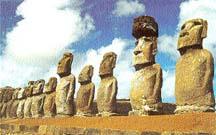
The ancestors of the people of Easter Island, according to local belief, can return as spirits in these statues. The familiar statues have captured the imagination of the world, and are part of a growing tourism industry on Easter Island. Archaeologist Jo Anne Tilberg, who spoke at Lawrence this past Monday, has done much work with these stautes and the history behind them. (southamericanfiesta.com)
This past Monday evening, the world’s leading expert on Easter Island addressed a Wriston auditorium audience. The lecture was made possible thanks to Appleton’s society for the Archaeological Institute of America.Ms. Van Tilberg’s talk focused on both the current and past residents of the island. She also took a deeper look at a few individuals whose lives have been woven into the fabric of the island’s history.
Easter Island, a treeless island measuing 160 square kilometers, is located in the South Pacific midway between Chile and Tahiti. The island was discovered by the West in 1722, but the explorer Thor Heyerdahl was responsible for the perception of the Easter Islanders as South Americans. This perception persisted until the first half of the 20th century. Now, the natives of Easter Island present their culture as Eastern Polynesian.
The island, which was settled sometime between 300 and 1000 A.D., contains 20,000 archaeological sites, making it a treasure trove of history in a concentrated area. The island has received much recognition for the ancient stone statutes of ancestors that measure on average fourteen feet tall and weigh eight to ten tons. The statues were generally part of an ancestor worship belief system.
Van Tilberg noted that the amazing size of these statues indicate certain characteristics of the people who made them. It shows that the Easter Islanders were either a rational and optimistic society that believed they could reach for greater heights in making larger and larger statues, or that they had lost control over their building through competition and lawlessness. However, due to consistency of aspects in the statue-making process over about 500 years, it implies at least a certain social order for that period.
In a project called the Easter Island Statue Project (for more information visit www.easterislandstatueproject.org), Van Tilberg directed a successful attempt to learn how the natives moved statues of such enormous size. There are 887 statues on the island, and 95 percent of them come from a single rock quarry, so they all had to be moved in some way. The project, which was filmed and aired by NOVA, demonstrated that s typical statue would take 40 people and an A-frame about a week to move a atatue ten miles, or the length of the island.
Easter Island has also been known as a place of disaster. The small land mass, which hosts a fragile environment that put untold strain on the residents of Easter Island, became a site of warfare and cannibalism. The treelessness of the Easter Island is due to the natives’ total deforestation of the island. When Katherine Routledge came to the island, much of the culture and oral tradition was on the brink of extinction.
Routledge, a British woman who was the first woman to graduate from Oxford, is the subject of Van Tilberg’s new book, Among Stone Giants: The Life of katherine Routledge and Her Remarkable Expedition to Easter Island. She and her husband had enough wealth to make an expedition to Easter Island from Southampton in 1913. When they arrived there, to spend the next 17 months, they found about 250 people living on the island.
During their stay, Katherine Routledge fell in love with the island and the people. It gave her a project to work on, and while she was there, through her notes and excavations, she became an important part of Easter Island’s history. Van Tilberg quoted someone as saying that she “brought history back to the island.”
Much of the value in her work stemmed out of her notes taken in partnership with Juan Tepano, a native whose remarkable foresight and worldliness allowed him to see that his culture was in need of preservation. Through their work with the elders of the island in particular, they were able to preserve many of the traditions and stories which the Easter Islanders present to the world today.
It is Ms. Van Tilberg’s hope that her own book and work has helped to prove the validity of Routledge’s work. Some discredit has been given to Routledge’s work based on Routledge’s affliction with schizophrenia, but Van Tilberg has done much to prove that the Routledge did not allow the mental illness to affect her work.
The lecture was part of the always fascination lectures presented at Lawrence by the Archaeological Institute of Amercia. It was the final lecture of this year, but be sure to look for further lectures to come.
